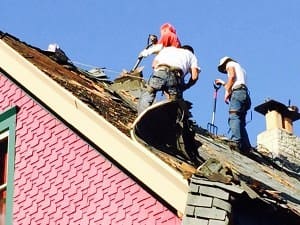The short answer to that question is that the optimal temperature to have your roof installed is when the temperature is between 45 degrees Fahrenheit and 85 degrees Fahrenheit.

Here in the upper midwest, homeowners regularly replace their roofs in the middle of summer. If homeowners understood how shingles are made they would probably change their buying habits.
Most shingles today are made from a combination of fiberglass matting, asphalt, and stone or ceramic aggregate. Understand those three elements and you can understand why mid-summer isn’t always the best time to have your roof installed.
Matting: This is made from either paper or fiberglass. It is what holds the shingle together until it is on your roof. Shingles with fiberglass (and thermoplastics) won’t swell up and break down as quickly as paper-based matting.
Asphalt: When a barrel of crude oil is refined, two products come from each barrel — gasoline and asphalt sludge. The sludge is what is used for shingles (and roads). The asphalt sludge is applied to the matting. New refining technologies (inspired by high gas prices) have allowed refiners to get more gasoline out of every barrel of crude oil. This means there is less asphalt to be sold on the marketplace. High demand and low supply of asphalt are key reasons why roofing has doubled over the last decade. In the summer there is more of a demand for asphalt due to road projects. The economic laws of supply and demand make summertime the most expensive time to put on your roof.
Aggregate: Before the asphalt hardens (solidifies) the aggregate is put onto the shingle and pressed in. This aggregate protects the underlying asphalt from drying out. The tighter the aggregate, the lower the possibility that the matting and asphalt will break down from heat, sunlight, and weather conditions. This is why some of the better manufacturers put extra aggregate on shingles which means that more will stick, but it also means that more will tend to slough off.
Summertime heat has benefits and it has drawbacks.
Benefits: Shingles have sealants on them that adhere to other shingles as well as starter strips. If your roofer uses starter strips, find out which kind and ask if they also use them in valleys and along rakes (gable ends).
Drawbacks: Heat softens up the asphalt which the aggregate sticks into. When roofers walk on it to install other parts of the roof, they can sometimes scuff up parts of the shingles. This is a smaller problem on low-slope roofs because the shoes of the roofers have more contact surfaces. On steep slope roofs, the heel of the foot tends to be lifted up higher to maintain balance. Less of the foot in contact with the roof means that more downward pressure per inch is applied to the shingles they have to step on. More downward (angled) pressure means more of a chance for scuffing and marring. I wouldn’t recommend installing a steep pitch roof with temperatures of 85 degrees Fahrenheit or above.
Wintertime is a high-risk time to install your roof
Temperatures below 45 degrees make shingles less pliable. Temperatures below freezing can crack as installers have to walk on them to get to other parts of the roof. The thermo-plastics that are used in the matting are very strong (think glass) but they are thin and with weight applied to them, can be brittle in cold temperatures. Since shingles are installed from the bottom up, the roofer must walk on the shingle to apply each subsequent shingle. If you must do a winter install, read this link.
If you have waited too long to have your roof installed, you may be faced with the tough decision of having to install a roof even in the middle of winter. Although not optimal conditions, the alternative may be severe damage to the internal parts of your house including damage to drywall, ceilings, insulation, and lumber which may be required for the structural integrity of your house. If you can wait until the temperature reaches 32 degrees Fahrenheit, then do.
Cold weather also brings with it difficulty in doing the installation. Air nail guns jam. Compressors don’t work well since the rings to help to maintain the pressure in the tanks are not as pliable under cold. Air hoses which are normally very pliable, are about as flexible as wire cables when it comes to moving around on the roof. Sealants will not apply very well and optimally, each shingle would have sealants applied to it but since it would take about 4 to 5 times as long to do a roof in this manner, I have yet to meet an installation company that uses those sealants.
The bottom line is that spring is the best time to install an asphalt shingle roof. You get the cooler temperatures (close to 50 degrees or so) that reduce scuffing, followed by the heat of warmer days in the near future to adhere the shingles to one another and reduce blow-off.
This is not to say that other times of year are horrible for installing a roof. If you have a leak you should replace your roof as soon as possible if it is a shingled roof. If your roof has damage and has a likelihood of failing within the next year, you should not take a chance. Damage to your roof decking and internal structures could result in bigger problems with rot.
Driveway destruction: I wouldn’t recommend that you have heavy trucks such as shingle delivery trucks or dumpster trucks on your driveway until the ground underneath has a chance to thaw. Remember that the frost line in the upper Midwest goes down to 3 feet. Give yourself at least a weeks worth of temperatures 40 degrees or warmer before you subject your driveway to unnecessary cracks. Many municipalities do not even allow trucking on their roads until after the spring thaw. If a homeowner is looking after their own driveway as much as municipalities look after their roads, you’ll want to keep note of the daily high temperatures.
###
Jim McGuigan is an Owens Corning Preferred Roofing Contractor based out of Milwaukee County. His business, Energy Masters, serves southeastern Wisconsin.

